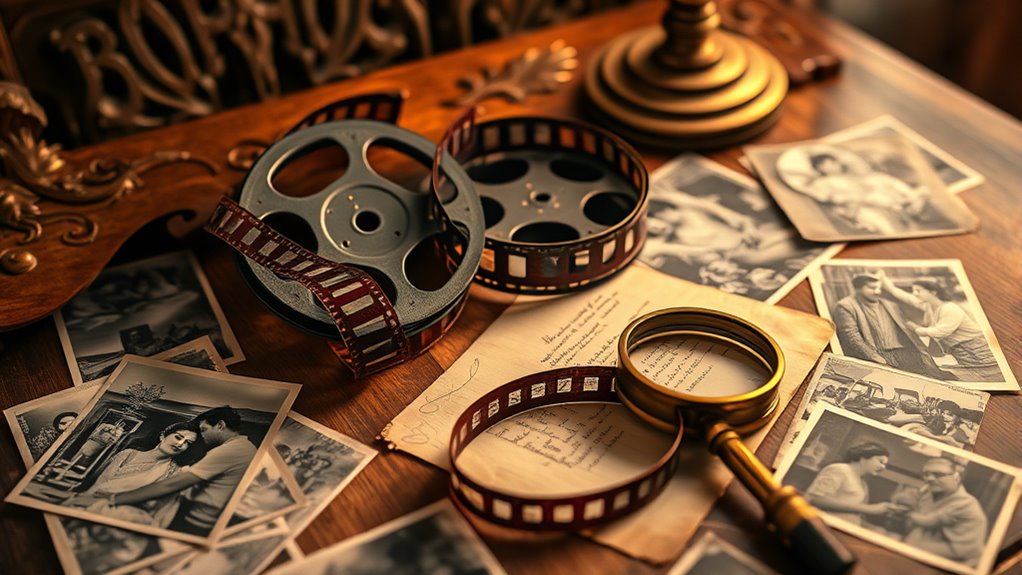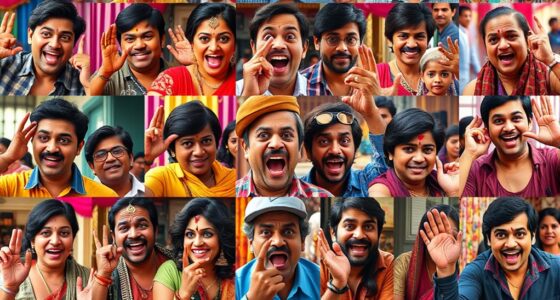Discover some hidden gems behind classic Bollywood films, from the costliest song scene in *Mughal-e-Azam* to the innovative reverse filming used in *Rockstar*. Learn how *Lagaan* built an authentic 100-acre village set or how lesser-known films tackled bold themes like adultery and social issues. Uncover the secrets behind costume craftsmanship and regional influences shaping stories. If you want to explore these lesser-known facts that add depth to Bollywood’s iconic history, there’s much more to uncover.
Key Takeaways
- The elaborate set for “Pyar Kiya To Darna Kya” cost over ₹1 crore, featuring authentic Lahore Mahal replicas and 105 song rewrites.
- *Mughal-e-Azam*’s costumes involved months of handcrafted embroidery, rare fabrics, and hidden jewelry details to achieve historical authenticity.
- Reverse filming techniques, like in *Rockstar*, were used to enhance emotional continuity and character consistency in complex scenes.
- The *Lagaan* village set was built on 100 acres in Kutch by 3,000 workers, reflecting colonial-era social hierarchy with regional craftsmanship.
- Lesser-known films like *Maya* (1993) challenged morality by depicting adultery and featuring rare nudity, pushing cinematic boundaries.
The Evolution of Film Titles: From Working Names to Blockbusters

Have you ever wondered how Bollywood film titles evolved from simple working names into iconic blockbusters? In the early days, single-word titles like Anand, Sholay, and Deewar dominated from the 1960s to the 1980s. These titles often reflected the protagonist or conveyed emotion, making them memorable and evocative. Simplicity was key, helping films stand out and connect with audiences. Genre also influenced titles—gangster films like Satya or romantic ones like Chandni used descriptive words. During the 1990s, this trend declined but saw a resurgence in the 2000s with titles like Fashion and Jannat. Over time, titles shifted from working placeholders to marketing tools, carefully chosen for their appeal, cultural resonance, and memorability, shaping Bollywood’s cinematic legacy. This evolution highlights the changing dynamics of film branding and audience engagement in Indian cinema. Additionally, advancements in film marketing strategies have played a significant role in how titles are crafted to attract diverse audiences worldwide, leveraging branding techniques to maximize recognition and appeal.
The Costly Grandeur of Mughal-e-Azam’s Iconic Song
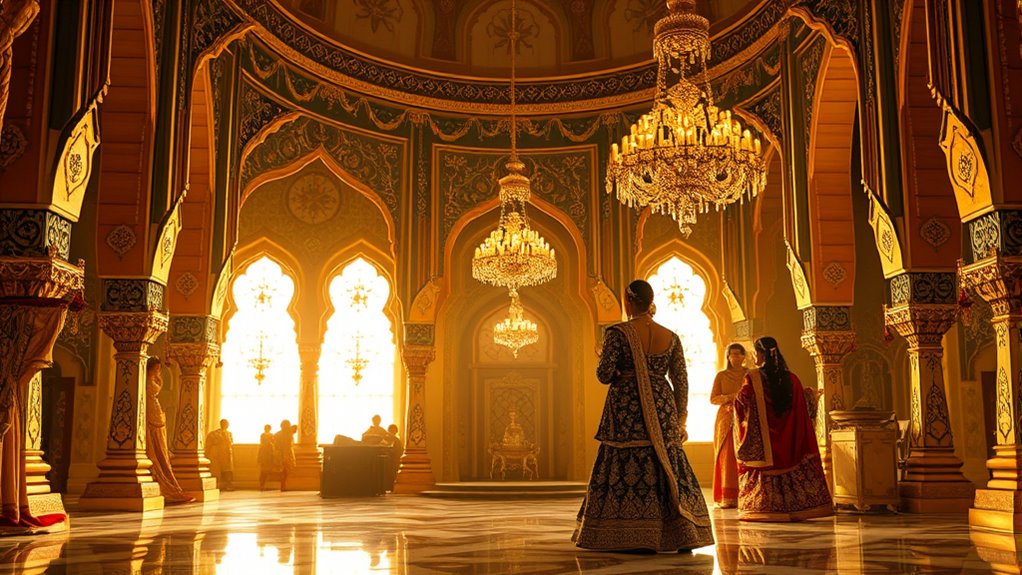
You’ll be surprised to learn that the set for “Pyar Kiya To Darna Kya” cost over ₹1 crore, making it one of the most expensive scenes of its time. The elaborate set, modeled after Lahore’s Sheesh Mahal, took two years to build and required extensive resources. Additionally, the song’s lyrics went through 105 rewrites, highlighting the meticulous effort behind its creation. This dedication to perfection helped elevate the overall grandeur of Mughal-e-Azam, cementing its place in Bollywood history. Moreover, the production team’s strategic planning ensured that every detail contributed to the film’s legendary status. A costly set like this not only showcases the film’s lavishness but also reflects the significant investment and resourcefulness involved in classic Bollywood productions.
Expensive Set Design
The set design for the iconic song “Pyar Kiya To Darna Kya” from Mughal-e-Azam exemplifies the extravagance and technical mastery of Indian cinema’s golden era. Built at Mohan Studios, the set measured 150 by 80 feet and 35 feet high, replicating Lahore Fort’s Sheesh Mahal. Constructed over two years, it cost over Rs 1 crore—more than most films’ entire budgets at the time. Using Belgian mirrors and real materials like wind-blown curtains, the set achieved remarkable authenticity. Hundreds of artisans worked tirelessly to bring it to life. Its grandeur set a new standard for Indian cinema, influencing future productions and becoming a cultural icon. The lavish expense showcased the film’s commitment to visual splendor, leaving a lasting legacy in cinematic history. Additionally, advances in set design technology have allowed filmmakers to create even more elaborate and immersive environments while managing costs more effectively. Modern techniques such as digital effects and computer-generated imagery have further expanded the possibilities for creating realistic set designs with greater efficiency. The combination of traditional craftsmanship and cutting-edge technology highlights the evolution of cinematic set creation, including the integration of digital tools that streamline production processes and enhance visual detail.
Multiple Song Rewrites
Creating the perfect version of “Pyar Kiya To Darna Kya” wasn’t a straightforward process; it involved countless revisions and intense brainstorming sessions. Naushad held overnight sessions with his team, relentlessly refining the melody and arrangement. Shakeel Badayuni revised the lyrics 105 times before Naushad finally approved them, ensuring every word resonated perfectly. The song drew inspiration from a folk tune from eastern Uttar Pradesh, adding authentic flavor. Lata Mangeshkar sang in a studio bathroom to create an echo effect, showcasing innovative recording techniques. Naushad’s perfectionism meant he spent endless hours fine-tuning each detail. These exhaustive efforts, combined with multiple rewrites, underscored the song’s grandeur, making it one of Bollywood’s most iconic and meticulously crafted classics. Additionally, the meticulous vetting process highlighted the importance of quality and taste in creating memorable film music. The dedication to sound quality played a crucial role in elevating the song’s timeless appeal. Moreover, Naushad’s commitment to dynamic communication exercises ensured the team worked seamlessly, reflecting the broader significance of collaboration in achieving artistic excellence. Incorporating home furnishings and other modern elements during production could have further enhanced the overall ambiance and authenticity of the scene. Involving community feedback during the production process could have further enhanced the song’s enduring charm.
Reverse Filming Techniques: Rockstar’s Unique Approach
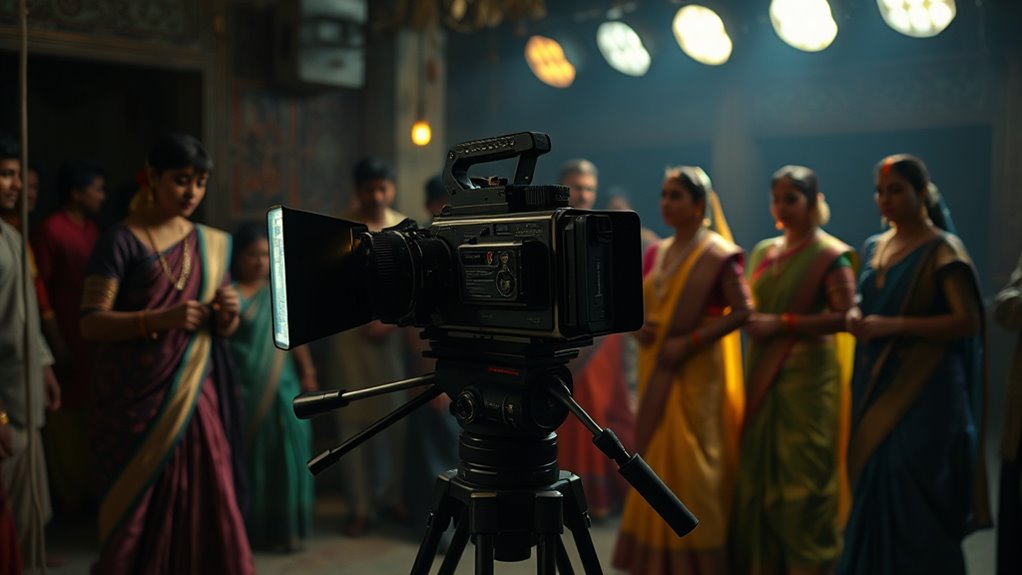
You’ll find that filming in reverse requires precise planning to keep scenes seamless. Shooting the climax first helped maintain the character’s hairstyle and overall continuity. This innovative approach presents unique challenges but results in a visually striking and cohesive story. Additionally, Halloween safety tips are essential to ensure that actors and crew remain protected during elaborate scenes involving special effects or costumes. Incorporating special effects safety protocols can further enhance on-set security and prevent accidents during complex filming sequences. Understanding industry trends can also aid filmmakers in adopting new techniques and maintaining safety standards on set. Recognizing the importance of holistic wellness in production environments can contribute to overall crew well-being and project success. Paying attention to website performance metrics can help streamline the filmmaking process and improve overall efficiency during production.
Reverse Shooting Strategy
Have you ever wondered how filmmakers maintain consistency in a character’s appearance while telling a non-linear story? In Rockstar, the reverse shooting strategy was key. The film shot major climax scenes first, allowing the actor to keep his long hairstyle intact across different timelines. This approach prevented forced changes or continuity errors, especially with the lead’s look. Shooting out of chronological order also helped match costume and hairstyle continuity, making transitions seamless. The decision prioritized visual authenticity and emotional impact over traditional linear filming. This innovative technique set a precedent in Bollywood, showcasing how flexible shooting strategies can enhance storytelling. By reversing the usual order, Rockstar ensured that character details remained consistent, helping audiences stay immersed in the protagonist’s emotional journey. Additionally, the use of hydrocolloid technology in acne patches demonstrates how advanced materials can significantly improve skin healing and clarity. Moreover, employing such innovative filming techniques can elevate a movie’s narrative depth and viewer engagement, similar to how regulatory considerations influence the planning and execution of complex projects in other industries.
Continuity Challenges
Rockstar faced several continuity challenges due to its complex non-linear narrative and diverse filming locations. The film’s non-linear structure meant scenes jumped between past, present, and future, making seamless progressions essential. To address this, the filmmakers used reverse filming, shooting scenes in reverse order—most notably the climax first—to maintain consistency. Ranbir Kapoor’s hairstyle was a significant concern; shooting backward helped keep his look uniform. The film also spanned locations like Prague and Kashmir, requiring meticulous planning to guarantee visual continuity. Cinematographer Anil Mehta played a crucial role in matching lighting and scenery across scenes. Extensive pre-production planning was fundamental, allowing the filmmakers to adapt seamlessly to these challenges and preserve the film’s emotional and visual coherence. Reverse filming techniques are not commonly used, but in Rockstar, they proved vital in maintaining the film’s narrative fluidity and visual integrity.
Language Barriers and Casting Surprises in Bollywood Classics
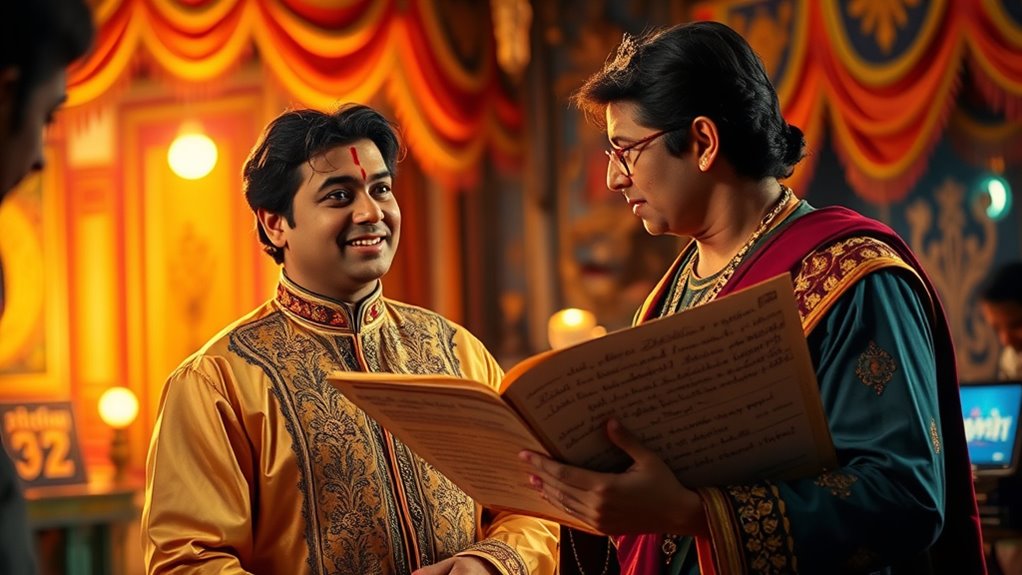
Despite language differences, Bollywood has consistently bridged communication gaps by focusing on universal themes and expressive storytelling that resonate across diverse audiences. Many classics have gained appreciation across India’s regions, thanks to relatable stories and emotions that transcend language barriers. Bollywood also serves as a cultural ambassador, sharing Indian values globally. The rise of OTT platforms further reduces language hurdles, making films accessible to wider audiences. Casting surprises are common; actors not fluent in Hindi have delivered iconic performances by adapting to roles and dialects, broadening the industry’s reach. Often, casting decisions consider regional appeal, boosting a film’s popularity. These factors, combined with regional cinema collaborations and code-switching, reflect Bollywood’s innovative approach to overcoming language challenges while enthralling diverse viewers.
The Epic Length and Authentic Sets of Lagaan
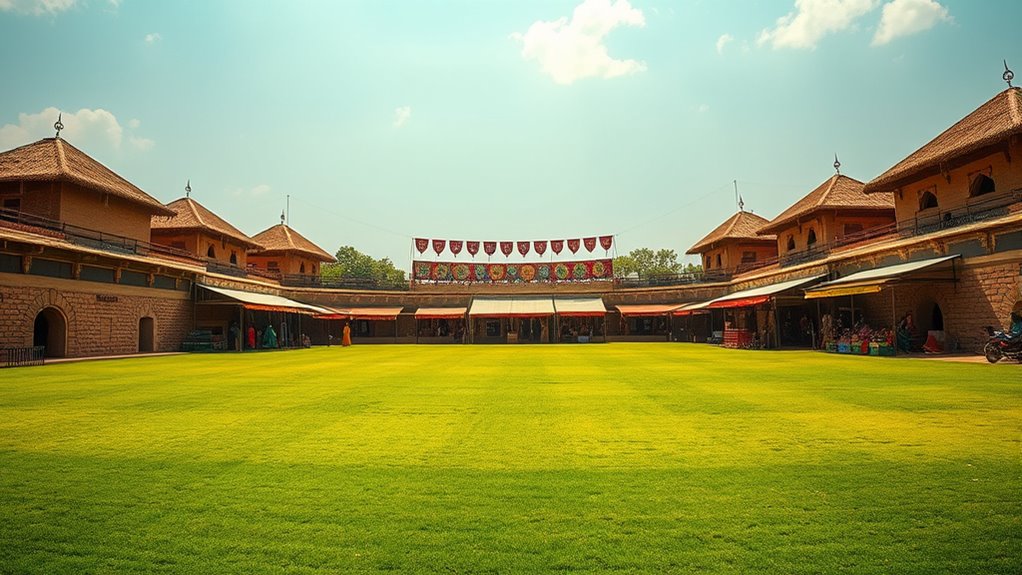
You’ll notice that Lagaan’s nearly four-hour runtime allows for a detailed portrayal of village life, cricket, and historical context, keeping viewers engaged throughout. The film’s authentic sets, created with precision and care, transport you directly into 1893 colonial India. This combination of length and realism makes the movie a grand, immersive experience that stands out in Bollywood history.
Authentic Set Design
The authentic set design of Lagaan stands out for its meticulous attention to detail and scale, bringing 19th-century rural India to life on screen. You witness this in the carefully constructed village of Champaner, built on 100 acres near Bhuj, blending natural landscape with colonial architecture. Over six months, a team of 3,000 workers created huts, British palaces, and a cricket ground, ensuring historical accuracy with materials and techniques. The cricket pitch was custom-made, using river mud to replicate authentic texture, and its shortened length suited filming needs. Costumes and props, designed by Bhanu Athaiya, added further realism, matching period styles and social roles. The set’s authenticity immerses you, transforming the film into a vivid, believable world of 1893 India.
| Feature | Details |
|---|---|
| Location | 100 acres near Bhuj, Kutch |
| Village Construction | 6 months, 3,000 workers |
| Key Structures | British palaces, huts, cricket ground |
| Cricket Pitch | Made with river mud, shortened to 9.5 yards |
| Costumes & Props | Authentic fabrics, period accessories |
Extended Runtime Experience
The extended runtime of Lagaan, lasting approximately 3 hours and 44 minutes, plays a crucial role in immersing you in its richly detailed world. This epic length allows for an elaborate narrative that covers village life, cricket training, and the climactic match, offering a deeper understanding of characters and themes. Shot in authentic rural locations near Bhuj, the film uses real villages, outdoor settings, and large-scale outdoor sets to enhance realism. Filmed with high-quality equipment and extensive post-production work, the visuals are stunning and immersive. The lengthy duration also enables thorough exploration of colonial oppression, social struggles, and emotional arcs, building tension gradually. Despite its size, the film keeps you engaged through pacing, musical sequences, and layered storytelling, resulting in a critically acclaimed and unforgettable viewing experience.
Regional Cinema Distinctions and Bollywood’s Unique Identity

Regional cinema has increasingly carved out its own distinct identity within India’s film industry, highlighting local traditions, languages, and storytelling styles that often differ from Bollywood’s glitzy mainstream approach. You’ll notice regional films emphasize cultural authenticity, lower production costs, and diverse genres, making them highly relatable to local audiences. Digital platforms have expanded their reach beyond state borders, fostering cross-cultural appreciation. This growth has influenced Bollywood, inspiring new storytelling techniques and encouraging collaborations. While Bollywood remains globally glamorous, regional cinema’s authentic narratives and cost-effective production have gained prominence. Here’s a snapshot of their differences:
| Aspect | Regional Cinema | Bollywood |
|---|---|---|
| Cultural Focus | Local traditions and languages | Fusion of diverse genres |
| Production Costs | Generally lower | Higher budgets |
| Talent | Emphasizes local talent | International stars |
| Visual Style | Authentic storytelling | Grand visuals and glamour |
| Audience Reach | Regional and online audiences | Global mainstream |
Unconventional Themes: Exploring Lesser-Known Films’ Bold Topics
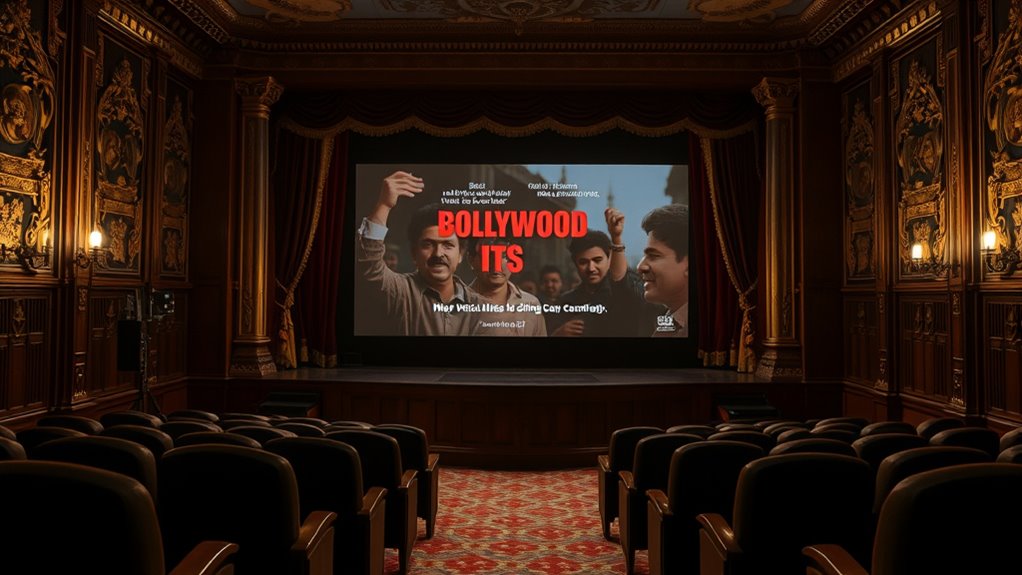
While Bollywood is often celebrated for its glamorous visuals and mainstream appeal, some filmmakers have pushed boundaries by exploring unconventional themes that challenge social norms and moral conventions. These lesser-known films dared to tackle bold topics, opening new storytelling avenues.
Bollywood’s bold films challenge norms, unveiling daring stories and fresh perspectives.
- *Maya* (1993) challenged traditional morality by depicting adultery as a valid choice and featuring rare nudity, breaking conservative norms.
- *Aar Ya Paar* (1997) explored opportunism, crime, and moral ambiguity, deviating from typical hero-villain stories and reflecting modern societal complexities.
- *Sankat City* (2009) introduced dark comedy and satire, critiquing middle-class aspirations and underground crime, marking a significant genre innovation in Bollywood.
These films reveal how Bollywood’s bold experimentation pushed the envelope, offering fresh perspectives and challenging audiences’ expectations.
Hidden Stories Behind Classic Film Costumes and Special Effects
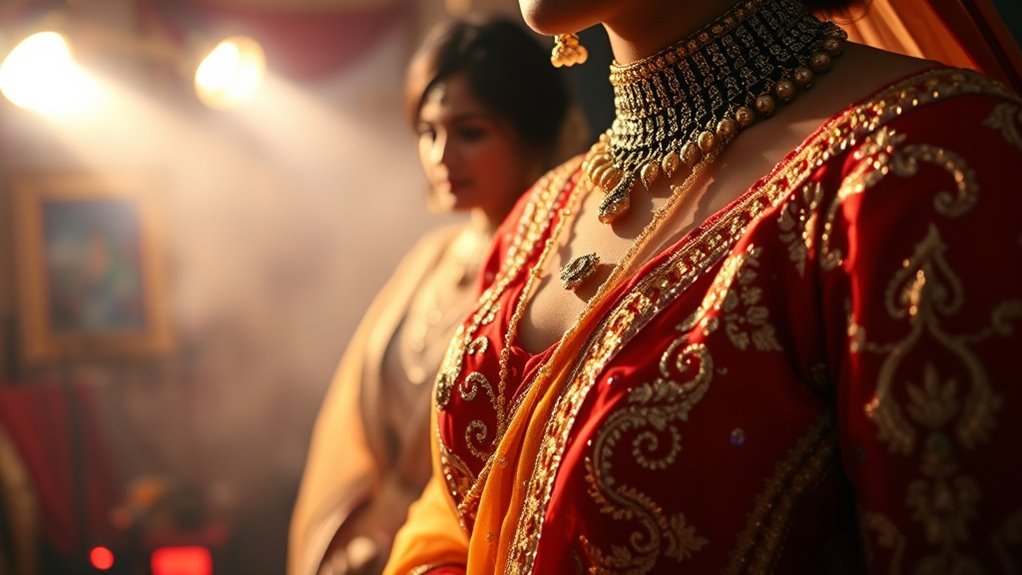
Behind every iconic Bollywood film costume lies a story of meticulous craftsmanship and creative ingenuity. Costumes for classics like Mughal-E-Azam and Devdas involved extensive research, with artisans handcrafting embroidery and sourcing rare fabrics to guarantee authenticity. Designers faced challenges, such as creating layered Mughal ensembles that limited movement, prompting innovative choreography and lightweight materials for comfort. Hidden details, like custom-made jewelry and fabric choices, enhanced visual storytelling, often requiring months of preparation. Special effects also played a role; digital enhancements blended costumes seamlessly into scenes, while lighting and camera work accentuated their grandeur. Despite constraints like budget and weather, designers pushed boundaries, transforming historical accuracy into cinematic spectacle. These behind-the-scenes efforts elevate costumes from mere attire to crucial storytelling tools that leave lasting impressions.
The Making of Champaner: Building the Village Set for Lagaan
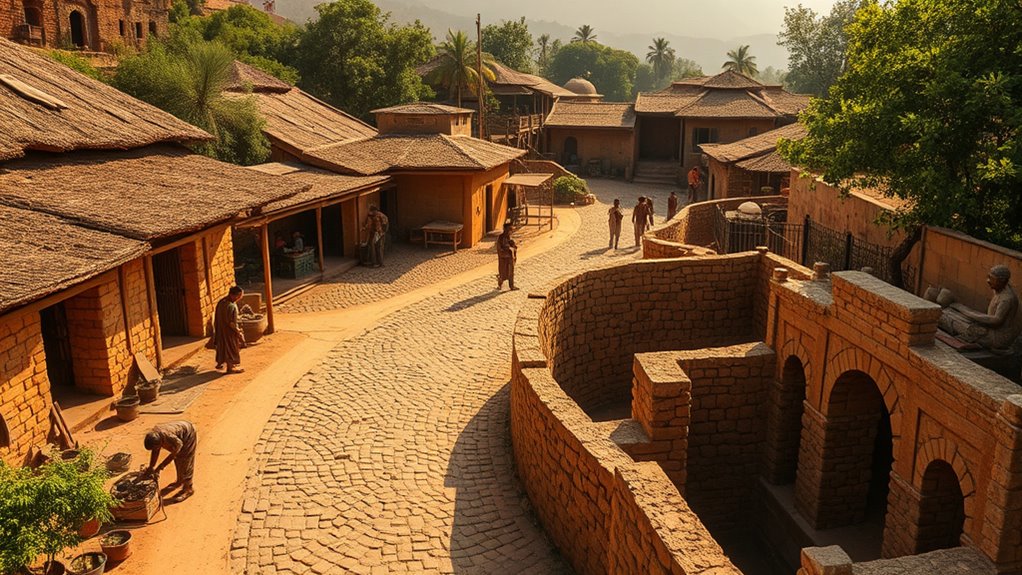
The creation of the Champaner village set for Lagaan showcases a remarkable blend of authenticity and dedication. You’re immersed in a project that took three months in 1999, with the site carefully chosen in Kutch after a seven-state search. The set spans over 100 acres, matching the region’s natural landscape and extreme climate. To guarantee realism, around 3,000 workers, including 150 artisans, used indigenous techniques without modern shortcuts.
You’ll find that:
- The set reflects social hierarchy with authentic housing styles for different castes.
- Local craftsmen played a key role in maintaining cultural accuracy.
- The entire process prioritized authenticity, from town planning to construction, led by local contractor Danabhai.
Surprising Inspirations and Influences From Regional Indian Films

Regional Indian films have profoundly shaped Bollywood’s storytelling, providing a rich tapestry of cultural themes, genres, and characterizations that Bollywood often adapts and integrates. You’ll notice how Bengali, Tamil, Telugu, Malayalam, and Kannada cinema introduce unique narratives rooted in local folklore, history, and customs, enriching Hindi films with diverse perspectives. Bollywood also draws inspiration from regional cinema’s complex female characters, like those seen in “Padmaavat,” showcasing emotionally layered women. The migration of actors and filmmakers from regional industries to Bombay has further infused Bollywood with regional influences. Genre conventions, music styles, and dance forms from regional films have shaped Bollywood’s signature style. Remakes and bilingual projects frequently preserve regional stories’ cultural essence, making Bollywood a vibrant mosaic of India’s cinematic diversity.
Frequently Asked Questions
How Did Bollywood Films Traditionally Choose Their Final Titles?
When choosing their final titles, Bollywood filmmakers consider several factors. You’ll see that they often collaborate closely, aiming for catchy, memorable names that appeal to target audiences. They also factor in cultural sensitivities, sometimes changing titles to avoid controversy. Additionally, technological advances and industry trends influence choices, with designers and marketers working together to craft titles that reflect the film’s theme, boost marketing, and reach wider audiences across languages and regions.
What Techniques Did Filmmakers Use to Manage High Costs in Classic Films?
You can see that filmmakers managed high costs by choosing cost-effective locations, optimizing scripts to reduce shooting days, and casting lesser-known actors to cut talent expenses. They also planned schedules carefully to avoid delays and used innovative financing like pre-sales and brand partnerships for funding. Additionally, they leveraged digital marketing and technological advances like CGI and digital prints to keep production and distribution costs down.
Why Are Reverse Filming Methods Rarely Used in Indian Cinema?
You might notice that reverse filming methods are rarely used in Indian cinema because they’re expensive and technically challenging. Filmmakers often prefer vibrant colors, choreography, and storytelling that connect culturally with audiences, making complex techniques less practical. Additionally, technological limitations in the past made reverse filming difficult, and today, budget constraints still influence choices. As a result, Indian filmmakers prioritize accessible, engaging visuals over costly, intricate filming methods like reverse techniques.
How Do Regional Films Influence Bollywood’s Storytelling and Themes?
You might not realize it, but regional films deeply influence Bollywood’s storytelling and themes. They bring authentic dialects, folklore, and cultural nuances that enrich mainstream movies. When you watch Bollywood, you see regional legends, festivals, and character traits that reflect India’s diversity. This cross-pollination helps create more relatable and vibrant stories, blending regional traditions with national narratives, making Bollywood films more authentic and emotionally resonant for audiences across the country.
What Inspired the Unconventional Themes in Lesser-Known Bollywood Movies?
You’re curious about what inspires the unconventional themes in lesser-known Bollywood movies. These films draw inspiration from real-life issues like gender inequality, health awareness, and societal struggles, pushing creative boundaries. They also reflect global trends, incorporate modern storytelling techniques, and explore cultural exchanges. This mix allows filmmakers to experiment freely, addressing taboo topics or niche interests, ultimately engaging audiences and sparking social and cultural conversations.
Conclusion
Just like uncovering hidden gems in a vast treasure chest, exploring these lesser-known facts about Bollywood classics reveals the magic behind the scenes. Each secret adds a new layer to your appreciation, showing that these films are more than just stories—they’re masterpieces crafted with passion and innovation. So next time you watch a Bollywood classic, remember there’s a world of fascinating secrets waiting to be discovered beneath its shimmering surface.
